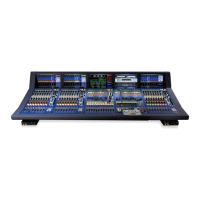20 Chapter 2: XL8 Live Performance System Overview
XL8 Control Centre
Operator Manual
Control software
The XL8’s operating system is Linux, which is an open-source, stable, proven operating
system (OS). Linux is used in many mission-critical applications worldwide and has
allowed Midas’ software engineers to write a ground-up system that contains no
‘hidden’ or unused code. This has resulted in an efficient, compact application, which is
quick in operation, quick booting and comparatively easy to debug.
Two copies of the master control software run on separate processors to provide
resilience to failure.
GUI
The XL8 has five, daylight-viewable, TFT screens that provide overview and detail
status indication. Any screen can display any information but, in the standard
configuration, screen information relates to module location. So, the input module
screens display their module’s input status, the mix module screen displays the
overview status screen (‘all the meters all the time’) and the output module screen
display is used for general use, such as automation, effects, GEQs, third party screens
etc. This is dependent on the current application (concerts will probably be different to
theatre) and also operator preference.
The screens are controlled via the navigation zones at the front of the modules. In the
output module’s primary navigation zone, two trackballs control the output module
(right trackball) and the mix module (left trackball). The equivalent on each input
module is a dedicated glidepad. A keyboard slides out from underneath the output
module to provide further control, such inserting text. USB keyboard input sockets at
the front of the control centre (under the left- and right-hand modules) allow the input
and mix screens to be controlled via an external keyboard should the output module
screen fail.
Resilience to failure (redundancy)
The XL8 Live Performance System is tolerant of any single failure of hardware or
software. To achieve this the system employs dual-redundancy, where a key
component has an identical redundant spare that is ready to take over should it fail.
Other failure scenarios are managed by the N+1 principle, where redundant
components form an acceptable fraction of the system; for example, one of the DSP
units in the rack is a redundant spare (see Figure 4 on page 21).
The control surface can tolerate multiple hardware failures without the operator losing
control of the audio. Any of the five GUI screens can be used to operate the whole
control centre, even if no control surface hardware is working.
The system includes diagnostic tools that give advance warning of any poor connectivity
(high error rates), internal temperatures and voltages etc. The system instantly alerts
the operator in the event of any hardware, software or connection failures, and
indicates the location of the fault. The system asks the operator what action to take,
but doesn’t automatically reconfigure. This is so that if, for example, the band is near
the end of a song and the audio is still ok, the mix engineer carry out corrective action
at a more opportune time.
Figure 5 on page 22 shows that even when all of one half of the system is down (the
greyed out portion) it will still function as normal. Although, in practise, it is highly
unlikely that this will ever happen.
Figure 6 on page 23 illustrates what happens when a router fails. Once again, the
system functions perfectly normally.

